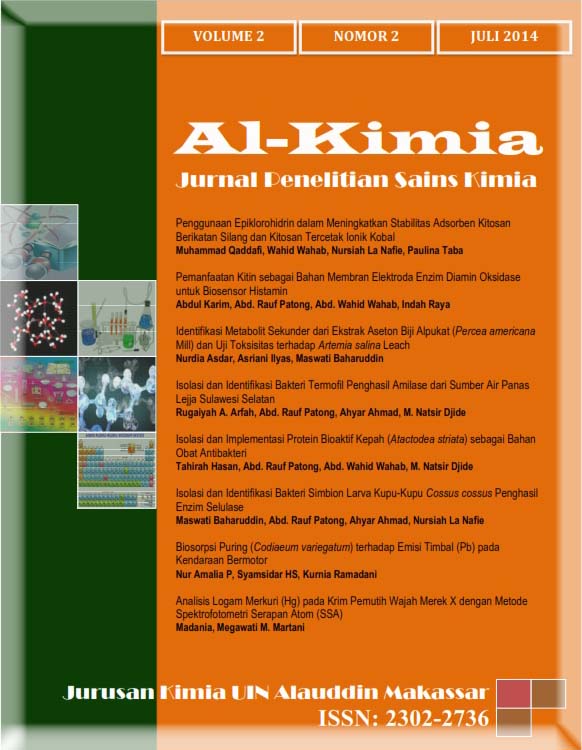Isolasi Dan Identifikasi Bakteri Termofil Penghasil Amilase Dari Sumber Air Panas Lejja Sulawesi Selatan
Abstract
A Research isolation and identification of bacteria termofil amylase from hot springs Lejja South Sulawesi has been done. This study aims to characterize the morphological, biochemical, genus and species of bacteria producing the enzyme amylase. The method used in this study through the stages: 1) Skrening and isolation of bacteria by means of as much as 1.0 mL of sample dilution plated on Petri dishes containing agar medium, then incubated for 20-24 hours at 50 °C, colonies of bacteria growing and has a colony morphology different character each taken 1 ose then etched into the amylolytic selective medium then incubated for 20-24 hours at 40oC and 50oC. Colonies that grew on selective media is scratched quadrant amylolytic to obtain pure isolates. Pure bacterial isolates taken 1 ose then grown in selective medium for 48 h at 50° C, bacterial isolates were grown spilled iodine solution (2% I2 and 0.2% KI) when there is a clearing zone around the colony indicated as the enzyme-producing bacterial isolates termofil amylase; 2) termofil characterization of bacterial isolates in microscopy with Gram stain; 3) isolates selected biochemical tests performed according to the method Bergey's Manual and Systematic of Bacteriology. Results of screening and isolation of 10 bacterial isolates obtained amylase through iodine test, selected 2 isolates, 1 isolate from water samples RSAII-1B and 1 isolates from water samples mixed sediment RSSII-4B, which has a diameter of clearing zone of 5.6 cm respectively and 5.15 cm; out such characterization results of gram stain microscopy showed that the 2 isolates including gram + and shaped bacillus, the colony morphology as observed macroscopically, microscopy and biochemical test results obtained RSAII isolates and isolates RSSII-1B-4B is a Bacillus sp.
Downloads
References
Abdel-Fattah, Y.R., Soliman, N.A., El-Toukhy N.M., El-Gendi H., and Ahmed R.S., 2012, Production, Purification and Characteriztion of Termostable α-amilase Produced by Bacillus licheniformis Isolate AI20, Jurnal Chemistry, 2012: 1-11.
Dirmawan, H. A., Suwanto, dan Purwadaria T., 2000, Eksplorasi Bakteri Termofil Penghasil Enzim Hidrolitik-Ekstraseluler dari Sumber Air Panas Gunung Pancar, Hayati, 7: 52-55.
Edwards, C., 1990, ”Thermophiles” Microbiology and Extreme Enviroments, (Ed): Alden Press Oxford.
Khairuddin, F., 2011, Lejj Wisat Permandian Andalan Sulawesi Selatan, Kompasiana 19 Juli 2011, Online, http://wisata.kompasiana.com/jalan- jalan/2011/07/19/lejja-wisata-permandian-andalan-sulawesi-selatan/ (Diakses 12 oktober 2011).
Natsir, H., 2010, Kajian Enzim Kitinase Termostabil dari Bakteri Termofil: Pemurnian, Karakterisasi, dan Aplikasi dalam Hidrolisis Kitin, Disertasi, Makassar: Program Pascasarjana MIPA-UNHAS.
Rasooli, I., Astaneh, S.D.A.A., Borna, H., and Barchini K.A., 2008, A Thermostable α-amilase Producing Natural Varient of Bacillus sp. Isolated from Soil in Iran. Am.J.Agri. & Biol. Sci. 3 (3): 591-296.
Santos E.O., and Martins M.L., 2003, Effeck Productof the Medium Composition on Formation of Amylase by Bacillus sp. Brazilian Arch Biol.Technol 46: 129-134.
Souza, P.M. De., and Magalhães, P.O. De., 2010, Application of Microbial α-amylase in Industry-A review. Online, Braz. J. Microbiol., 41 (4), http://dx.doi.org/10.1590/S1517-838220100 (Diakses 19 Oktober 2011).
Suhartono, M. T., 1989, Enzim dan Bioteknologi, Depdikbud-Dikti, Bogor: PAU Bioteknologi-IPB.
Sutiamiharja, N., 2008, Isolasi Bakteri dan Uji Aktivitas Amilase Kasar Termofilik dari Sumber Air Panas Gurukinayan Karo Sumatra Utara. Tesis. Medan: Pascasarjana Universitas Sumatra Utara.
Authors who publish with this journal agree to the following terms:
1) Authors retain copyright and grant the journal right of first publication with the work simultaneously licensed under a Creative Commons Attribution License that allows others to share the work with an acknowledgement of the work's authorship and initial publication in this journal.
2) Authors are able to enter into separate, additional contractual arrangements for the non-exclusive distribution of the journal's published version of the work (e.g., post it to an institutional repository or publish it in a book), with an acknowledgement of its initial publication in this journal.
3)Authors are permitted and encouraged to post their work online (e.g., in institutional repositories or on their website) prior to and during the submission process, as it can lead to productive exchanges, as well as earlier and greater citation of published work (See The Effect of Open Access).


